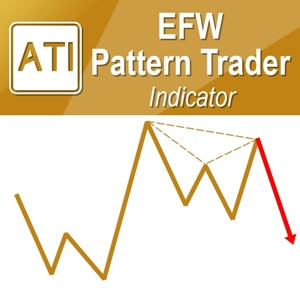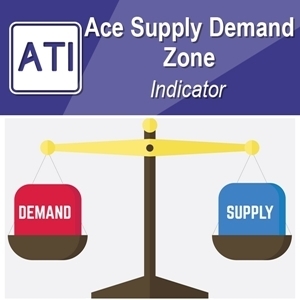Channelling Techniques with Elliott Wave
During the development of the Wave Principle, Elliott suggested that channelling technique could be useful devise to anticipate the future wave movement. Elliott developed the three channelling techniques when Wave 2, 3 and 4 is completed respectively. We explain the steps of drawing the channels from the case of wave 2 completion to wave 4 completion.
When wave 2 is completed, trader can draw the first upper channel line and base line to anticipate the location of wave 3 (Figure 5-14). Drawing upper channel line is simple. Firstly, draw the base line by connecting the starting point of wave 1 and the ending point of wave 2. Then draw the parallel line to the first base line passing through the ending point of wave 1. Elliott suggested that wave 3 can be completed near the first upper channel line. Practically speaking, this upper channel line provides only the rough guideline for the location of the wave 3. Wave 3 can be completed below or above this upper channel line.
When wave 3 is completed, we can draw second upper channel line and base line to anticipate wave 4 (Figure 5-15). Firstly, draw second upper channel line by connecting the ending point of wave 1 and the starting point of wave 3. Then draw second base line parallel to the new upper channel line passing through the ending point of wave 2. The second base line can be used to anticipate the rough location of wave 4.
When wave 4 is completed, we can draw the final base line and upper channel line to anticipate the rough location of wave 5 (Figure 5-16). Firstly, draw new base line by connecting the ending point of wave 2 and wave 4. Then draw the final upper channel line parallel to the final base line passing through the starting point of wave 3. With the new upper channel line, trader can anticipate the rough location of wave 5.
Figure 5-14: Drawing base line and upper channel line when wave 2 is completed.
Figure 5-15: Drawing base line and upper channel line when wave 3 is completed.
Figure 5-16: Drawing base line and upper channel line when wave 4 is completed.
Some More Tips about Channelling Techniques with Elliott Wave
Channelling techniques with Elliott Wave in forex trading involve using trend channels to help identify and confirm the wave structures, target potential price movements, and manage trades more effectively. This method enhances the understanding and application of Elliott Wave Theory by providing visual boundaries within which the waves operate.
Elliott Wave Theory Recap
Basic Structure
- Impulsive Waves:
- Consist of five sub-waves (labeled 1, 2, 3, 4, 5) that move in the direction of the primary trend.
- Corrective Waves:
- Consist of three sub-waves (labeled A, B, C) that move against the primary trend.
Principles
- Wave 1, 3, and 5: Move in the direction of the trend.
- Wave 2 and 4: Are corrective and move against the trend.
- Wave A, B, and C: Form the corrective phase following the impulsive wave.
Channelling Techniques
Concept
Channelling techniques involve drawing parallel lines (channels) around price movements to help identify the boundaries within which Elliott Waves develop. These channels help traders visualize the wave structure and set potential targets and stop-loss levels.
Types of Channels
- Standard Channels:
- Drawn by connecting the ends of impulse waves and extending them forward.
- Base Channels:
- Constructed at the start of a new trend by connecting the beginning of Wave 1 and the end of Wave 2 and projecting a parallel line from the end of Wave 1.
- Acceleration Channels:
- Used when the trend accelerates, drawn by connecting the end of Wave 2 and Wave 4 and projecting a parallel line from the end of Wave 1.
- Deceleration Channels:
- Used when the trend decelerates, drawn by connecting the end of Wave 3 and Wave 5 and projecting a parallel line from the end of Wave 4.
Drawing Channels
- Impulsive Wave Channels:
- Wave 1-3-5 Channel: Connect the end of Wave 1 and Wave 3, then draw a parallel line from the end of Wave 2. This channel typically contains Waves 1, 2, 3, and 4, with Wave 5 often breaking through the upper boundary in an uptrend.
- Corrective Wave Channels:
- Wave A-B-C Channel: Connect the end of Wave A and Wave C, then draw a parallel line from the end of Wave B. This helps contain the corrective phase and predict the endpoint of Wave C.
Application in Trading
Identifying Trends and Reversals
- Trend Identification:
- Channels help confirm the wave count and the direction of the primary trend.
- If the price stays within the channel, it confirms the trend. If it breaks out, it may signal a trend reversal or acceleration.
- Reversal Signals:
- When Wave 5 breaks through the channel boundary, it can signal the end of the impulsive phase and the start of a corrective phase.
Setting Targets and Stop-Losses
- Targeting:
- Use channels to set price targets for Waves 3 and 5 in an impulsive sequence.
- For corrective waves, the endpoint of the channel can help set targets for Wave C.
- Stop-Loss Placement:
- Place stop-loss orders outside the channel boundaries to protect against unexpected breakouts.
Example: Applying Channels to Elliott Waves
Scenario: Analyzing GBP/USD on a daily chart.
- Identify Impulsive Waves:
- Identify Waves 1, 2, and 3.
- Draw the Channel:
- Connect the end of Wave 1 and Wave 3, and draw a parallel line from the end of Wave 2.
- Target Wave 5:
- Anticipate Wave 4 to remain within the channel and project Wave 5 to potentially exceed the upper boundary, signaling the end of the impulsive phase.
- Corrective Phase:
- After Wave 5 completion, identify Waves A, B, and C.
- Draw a corrective channel by connecting the end of Wave A and Wave C, with a parallel line from the end of Wave B.
Practical Trading Strategy
Trend Continuation
- Entry Point:
- Enter a long position at the end of Wave 2 within the channel, anticipating the formation of Wave 3.
- Confirm the entry by checking if the price is respecting the channel boundaries.
- Stop-Loss:
- Place a stop-loss below the end of Wave 2.
- Take-Profit:
- Set the take-profit target at the upper boundary of the channel or slightly above, anticipating Wave 3 completion.
Reversal Trading
- Entry Point:
- Enter a short position when Wave 5 breaks through the upper boundary of the impulsive channel, indicating a potential trend reversal.
- Stop-Loss:
- Place a stop-loss above the breakout point.
- Take-Profit:
- Target the lower boundary of the corrective channel or the end of Wave C.
Conclusion
Channelling techniques with Elliott Wave provide a structured way to visualize and trade market trends and reversals. By drawing channels around wave structures, traders can better identify the direction of the trend, anticipate potential price targets, and manage risk more effectively. This approach enhances the practical application of Elliott Wave Theory, making it a valuable tool for forex traders aiming to navigate the complexities of market movements.
About this Article
This article is the part taken from the draft version of the Book: Scientific Guide To Price Action and Pattern Trading (Wisdom of Trend, Cycle, and Fractal Wave). This article is only draft and it will be not updated to the completed version on the release of the book. However, this article will serve you to gather the important knowledge in financial trading. You can get the book to get the most up to date trading strategy for your technical analysis.
Elliott Wave Trend is extremely powerful indicator. Allow you to perform Elliott wave counting as well as Elliott wave pattern detection. On top of them, it provides built in accurate support and resistance system to improve your trading performance.
https://www.mql5.com/en/market/product/16479
https://www.mql5.com/en/market/product/16472
https://algotrading-investment.com/portfolio-item/elliott-wave-trend/
Related Products









